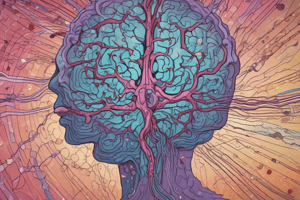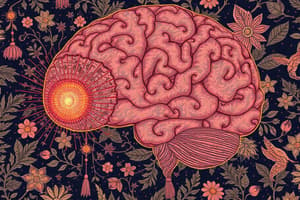Podcast
Questions and Answers
What is epilepsy primarily characterized by?
What is epilepsy primarily characterized by?
Which of the following describes status epilepticus?
Which of the following describes status epilepticus?
What is the primary cause of idiopathic epilepsy?
What is the primary cause of idiopathic epilepsy?
Which type of epilepsy involves identifiable causes such as infections or trauma?
Which type of epilepsy involves identifiable causes such as infections or trauma?
Signup and view all the answers
What is the typical approach when initiating antiepileptic drug therapy?
What is the typical approach when initiating antiepileptic drug therapy?
Signup and view all the answers
What is a common outcome if antiepileptic drug therapy is stopped abruptly?
What is a common outcome if antiepileptic drug therapy is stopped abruptly?
Signup and view all the answers
What is the goal of antiepileptic drug therapy?
What is the goal of antiepileptic drug therapy?
Signup and view all the answers
Which population is most commonly affected by epilepsy?
Which population is most commonly affected by epilepsy?
Signup and view all the answers
Which condition is NOT indicated for carbamazepine?
Which condition is NOT indicated for carbamazepine?
Signup and view all the answers
What is the mechanism of action for gabapentin?
What is the mechanism of action for gabapentin?
Signup and view all the answers
Which of the following is a common adverse effect associated with phenytoin?
Which of the following is a common adverse effect associated with phenytoin?
Signup and view all the answers
What should be monitored due to the drug interactions of phenytoin?
What should be monitored due to the drug interactions of phenytoin?
Signup and view all the answers
Which drug is indicated as adjunct therapy for neuropathic pain?
Which drug is indicated as adjunct therapy for neuropathic pain?
Signup and view all the answers
In which situation is slow IV administration of phenytoin recommended?
In which situation is slow IV administration of phenytoin recommended?
Signup and view all the answers
What common adverse effect is associated with the use of pregabalin?
What common adverse effect is associated with the use of pregabalin?
Signup and view all the answers
What is a potential consequence of abruptly stopping antiepileptic medication?
What is a potential consequence of abruptly stopping antiepileptic medication?
Signup and view all the answers
Which fluid should be used when administering IV phenytoin?
Which fluid should be used when administering IV phenytoin?
Signup and view all the answers
Why is regular and consistent dosing important in the treatment of seizures?
Why is regular and consistent dosing important in the treatment of seizures?
Signup and view all the answers
What should patients do to monitor their response to antiepileptic drugs?
What should patients do to monitor their response to antiepileptic drugs?
Signup and view all the answers
What is one role of neurotransmitters in mental health disorders according to the biochemical imbalance theory?
What is one role of neurotransmitters in mental health disorders according to the biochemical imbalance theory?
Signup and view all the answers
What is a common reason for prescribing psychotherapeutic drugs?
What is a common reason for prescribing psychotherapeutic drugs?
Signup and view all the answers
What should a patient do if their antiepileptic medication does not reduce the frequency of seizures?
What should a patient do if their antiepileptic medication does not reduce the frequency of seizures?
Signup and view all the answers
What should patients be taught regarding the duration of antiepileptic therapy?
What should patients be taught regarding the duration of antiepileptic therapy?
Signup and view all the answers
What is the primary goal of therapeutic drug monitoring for seizure disorders?
What is the primary goal of therapeutic drug monitoring for seizure disorders?
Signup and view all the answers
Which of the following is NOT a primary pharmacological effect of antiepileptic drugs (AEDs)?
Which of the following is NOT a primary pharmacological effect of antiepileptic drugs (AEDs)?
Signup and view all the answers
Which of the following adverse effects is commonly associated with antiepileptic drugs?
Which of the following adverse effects is commonly associated with antiepileptic drugs?
Signup and view all the answers
What classification do phenobarbital and phenytoin fall under?
What classification do phenobarbital and phenytoin fall under?
Signup and view all the answers
How does the mechanism of action of AEDs affect neuron function?
How does the mechanism of action of AEDs affect neuron function?
Signup and view all the answers
Which of the following drugs has been commonly used as a first-line antiepileptic drug?
Which of the following drugs has been commonly used as a first-line antiepileptic drug?
Signup and view all the answers
_______________ for mothers with epilepsy (whether on medications or not). Mother should continue on with therapy.
_______________ for mothers with epilepsy (whether on medications or not). Mother should continue on with therapy.
Signup and view all the answers
What are the most common types of psychotherapeutic drugs prescribed for anxiety?
What are the most common types of psychotherapeutic drugs prescribed for anxiety?
Signup and view all the answers
Which of the following statements correctly describes anxiety?
Which of the following statements correctly describes anxiety?
Signup and view all the answers
What is the primary action of anxiolytic drugs in the treatment of anxiety?
What is the primary action of anxiolytic drugs in the treatment of anxiety?
Signup and view all the answers
Which of the following is NOT a distinct anxiety disorder?
Which of the following is NOT a distinct anxiety disorder?
Signup and view all the answers
Which class of drugs is known for causing sedation and is not recommended for long-term use?
Which class of drugs is known for causing sedation and is not recommended for long-term use?
Signup and view all the answers
What is a significant advantage of buspirone compared to benzodiazepines?
What is a significant advantage of buspirone compared to benzodiazepines?
Signup and view all the answers
What is one of the primary concerns with the prescription of psychotherapeutic drugs?
What is one of the primary concerns with the prescription of psychotherapeutic drugs?
Signup and view all the answers
Which drug class is most likely to interact with selective serotonin reuptake inhibitors (SSRIs)?
Which drug class is most likely to interact with selective serotonin reuptake inhibitors (SSRIs)?
Signup and view all the answers
Study Notes
Epilepsy
- Epilepsy is a chronic neurological disorder caused by excessive electrical activity in the brain, leading to a range of symptoms from sensory disturbances to severe convulsive seizures.
- Seizures are brief episodes of abnormal electrical activity in brain cells, that may or may not lead to a convulsion.
- A convulsion is an involuntary spasmodic contraction of muscles throughout the body.
- Epilepsy is often diagnosed using an electroencephalogram (EEG).
- Epilepsy is more common in children and older adults.
- Some evidence suggests a genetic predisposition to epilepsy.
- Primary epilepsy (idiopathic) has an unknown cause and accounts for roughly 50% of cases.
- Secondary epilepsy (symptomatic) has an identifiable cause, such as trauma, infection, or cerebrovascular disorder. Infants and children are particularly susceptible to secondary epilepsy due to factors like fever, developmental defects, birth injuries, and metabolic diseases.
Classification of Epilepsy
- Generalized seizures involve both hemispheres of the brain, leading to loss of consciousness and awareness.
- Focal seizures originate in one hemisphere and may or may not cause loss of consciousness.
- Status Epilepticus is a neurological emergency characterized by prolonged seizure activity, lasting 5 minutes or longer.
- Continuous seizure activity can lead to hypotension, hypoxia, brain damage, and even death.
Antiepileptic Drugs
- Antiepileptic drugs (AEDs) are also known as anticonvulsants.
- The primary goals of AED therapy are to control or prevent seizures and maintain a reasonable quality of life.
- AED therapy is typically lifelong for many patients.
- Abruptly stopping AEDs can lead to withdrawal seizures.
- Combination drug therapy is often used.
- 70% of patients are generally seizure-free on monotherapy, while 30% require multiple drugs.
- Single-drug therapy is initiated before multiple-drug therapy is considered.
- Serum drug concentrations must be measured regularly.
- If seizures are not controlled, serum drug levels should be checked to ensure they are within therapeutic ranges.
- The exact mechanism of action of AEDs is unknown.
- AEDs may stabilize neuron membranes by reducing electrolyte movement, including sodium, potassium, calcium, and magnesium.
Antiepileptic Drugs Effects
- AEDs primarily reduce neuron excitability in the motor cortex, suppress the transmission of seizure impulses, and decrease the speed of nerve impulse conduction within a neuron.
- AEDs are indicated to prevent or control seizures, for long-term maintenance therapy of chronic recurring seizures, and for the acute treatment of convulsions and status epilepticus.
- AEDs can cause numerous adverse effects, which vary by drug.
- Adverse effects often limit the drug's usefulness and may necessitate a change in medication.
- Immune reactions and skin lesions, including Stevens-Johnson Syndrome, are common.
- Women with epilepsy have a higher incidence of birth defects, regardless of whether they are taking medication.
Traditional AED Classifications
- Four main traditional AED classifications include:
- Barbiturates
- Hydantoins
- Iminostilbenes
- Miscellaneous
Barbiturates - Phenobarbital
- Phenobarbital is a Schedule IV controlled substance.
- Indications for phenobarbital include generalized seizures and partial/focal seizures.
- Sedation is the most common adverse effect.
- Phenobarbital has a long half-life.
- It interacts with many drugs.
Hydantoins - Phenytoin
- Phenytoin (Dilantin) is a first-line antiepileptic drug.
- Indications for phenytoin include generalized seizures and partial/focal seizures.
- Adverse effects of phenytoin include gingival hyperplasia, increased acne growth, and increased body hair growth in unusual places.
- IV administration of phenytoin is irritating to veins and must be administered slowly into a large vein.
- Phenytoin is highly protein-bound in plasma, leading to potential drug interactions.
- Phenytoin induces liver enzymes, increasing the metabolism of other drugs.
- Phenytoin effects are exaggerated in patients with hypoalbuminemia, such as those with malnutrition or chronic kidney failure.
- Phenytoin is effective, generally well-tolerated, inexpensive, and has a relatively long half-life.
- Phenytoin is contraindicated in patients with bradycardia or heart block.
Iminostilbenes - Carbamazepine
- Carbamazepine (Tegretol) is the second most commonly prescribed antiepileptic drug in Canada after phenytoin.
- Indications for carbamazepine include generalized tonic-clonic seizures and partial/focal seizures, where it is considered a first-line treatment.
- Carbamazepine is contraindicated for other generalized seizures, such as myoclonic and absence seizures.
- Common adverse reactions include headache, dizziness, unusual eye movements, visual changes, and behavioral changes.
- It interacts with many drugs.
Miscellaneous AEDs
-
Gabapentin (Neurontin) is a chemical analogue of gamma-aminobutyric acid (GABA), a neurotransmitter that inhibits brain activity.
-
Gabapentin's mechanism of action is believed to increase GABA synthesis and accumulation between neurons.
-
Gabapentin is indicated as an adjunct and prophylactic treatment for partial seizures.
-
Gabapentin is contraindicated in patients with a known drug allergy.
-
Adverse effects of gabapentin include CNS and GI symptoms.
-
Gabapentin interacts with alcohol, producing additive CNS depression.
-
Levetiracetam (Keppra) has an unknown mechanism of action.
-
Levetiracetam is indicated for adjunct therapy for partial seizures with or without secondary generalization.
-
It is contraindicated in patients with a known drug allergy.
-
Levetiracetam is well-tolerated, with potential CNS effects as the primary adverse effect.
-
Levetiracetam can cause CNS depression when combined with other sedating drugs.
-
Pregabalin (Lyrica) is structurally related to GABA and gabapentin.
-
It is indicated as adjunct therapy for partial seizures, but its primary uses are not for seizures, but for neuropathic pain, post-herpetic neuralgia.
-
Pregabalin is contraindicated in patients with a known drug allergy.
-
Adverse effects include dizziness, drowsiness, peripheral edema, and blurred vision.
-
It is only available for oral use.
Nursing Implications: Antiepileptics
-
Assessment:
- Comprehensive health history including current medications and allergies.
- Liver function studies and complete blood count.
- Baseline vital signs.
-
Oral Administration
- Oral AEDs should be taken regularly at the same time each day.
- Take with meals to decrease GI upset.
- Do not crush, chew, or open extended-release forms.
- If the patient is NPO for a procedure, contact the prescriber regarding AED dosage.
-
Regular, consistent dosing is critical for successful treatment.
- Abrupt withdrawal can lead to rebound seizure activity.
-
IV Forms:
- Monitor vital signs during IV AED administration.
- Use only normal saline (0.9% sodium chloride) with IV phenytoin (Dilantin).
-
Patient Education:
- Encourage patients to keep a journal to track:
- Response to drug
- Seizure occurrence and descriptions
- Adverse effects
- Emphasize that AEDs must be gradually tapered, as abrupt discontinuation can cause rebound seizure activity.
- Patients should wear a medical alert tag.
- Explain that AED therapy is long-term and may be lifelong.
- Monitor patients for adverse effects, including mental status changes, mood changes, changes in level of consciousness, eye problems, and visual disorders.
- If seizures are not reduced, serum drug levels should be tested.
- Encourage patients to keep a journal to track:
Psychotherapeutic Drugs
- Most people experience normal emotions, such as anxiety, depression, and grief, which are often situational.
- Psychotherapeutic medications are typically considered second-line treatment but may be indicated when emotions or behaviors compromise quality of life, social relationships, or daily activities.
- The ability to cope with emotions can range from occasional depression or anxiety to constant emotional distress.
- Treatment will focus on three common types of mental health disorders:
- Anxiety
- Affective disorders
- Psychotic disorders
- The etiology of mental health disorders is not clear, with numerous theories proposed.
- The biochemical imbalance theory attributes mental health disorders to abnormal levels of neurotransmitters.
- Dopamine, norepinephrine, serotonin, histamine, GABA, and acetylcholine may play a role in mental health disorders.
- Symptoms often overlap, and patients may have comorbid conditions, making diagnosis and treatment more challenging.
- Psychotherapeutic drugs are used to treat emotional and mental disorders, including anxiety, affective disorders, and psychotic disorders.
- The most commonly prescribed psychotherapeutic drugs in Canada include:
- Anxiolytic drugs (anxiety)
- Mood-stabilizing drugs (affective disorders)
- Antidepressant drugs (affective disorders)
- Antipsychotic drugs (psychotic disorders)
Anxiolytic Drugs (Anxiety)
- Anxiety is an unpleasant state of mind characterized by dread and fear.
- Transient situational anxiety is typically distinguished from significant and persistent symptoms lasting longer than 6 months.
- Symptoms of anxiety include feeling on edge, restlessness, fatigue, difficulty sleeping, and trouble concentrating.
- Anxiety may be triggered by anticipated or past experiences, or exaggerated responses to imaginary negative situations.
- Anxiety differs from fear, as it is a future-oriented mood state where individuals are not prepared to cope with upcoming negative events.
Types of Anxiety Disorders
- Separation anxiety disorder
- Selective mutism
- Specific phobia
- Social anxiety disorder (social phobia)
- Panic disorder
- Panic attack
- Agoraphobia
- Generalized anxiety disorder
- Substance- or medication-induced anxiety disorder
Anxiolytic Drug Mechanism of Action
- Anxiolytic drugs reduce anxiety by reducing overactivity in the central nervous system (CNS).
- Two primary drug classes include benzodiazepines and buspirone.
- Benzodiazepines depress neurotransmitter activity in the brainstem and limbic system.
-
Buspirone is a non-sedating, non-habit-forming anxiolytic.
- Buspirone may interact with selective serotonin reuptake inhibitors (SSRIs) that can lead to serotonin syndrome.
- Do not administer buspirone with monoamine oxidase inhibitors (MAOIs).
Benzodiazepines
- Benzodiazepines are also known as benzo's.
- They are considered minor tranquilizers.
- Most benzodiazepines contain "zep" and end in "epam" or "zolam".
- The "Zzzzzs" in the name can be associated with their tranquilizer effect of inducing sleep.
- Benzodiazepines are not designed for long-term use due to their addiction potential.
Studying That Suits You
Use AI to generate personalized quizzes and flashcards to suit your learning preferences.




